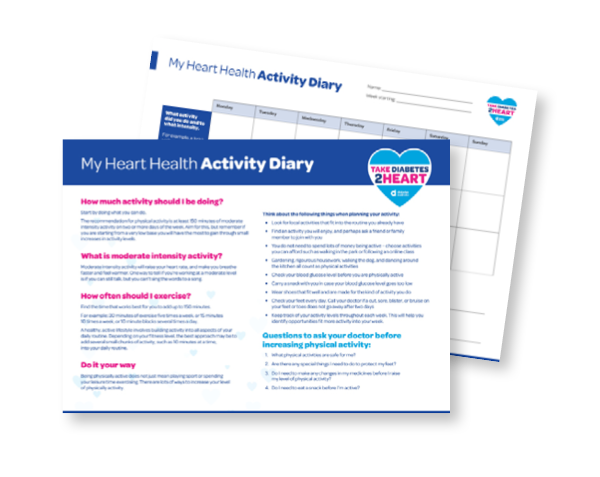Be physically active
Regular physical activity can lower blood pressure and help reduce your risk of a heart attack and stroke, with as little as 30 minutes a day of exercise having a positive impact. However, not everyone is the same, so it’s best to chat with your doctor to ascertain what level of physical activity and exercise is suitable for you.
keep an activity diary
Starting a new exercise program can take a lot of effort, and not just physically! Understanding new exercises, keeping track of progress and remembering to fit exercise into your busy schedule be difficult. However, with an Activity Diary, you can keep track of what exercises you should be doing each day, your progress, and what areas you and your health team should discuss further.
If you’re not sure what an Activity Diary should include, check out our Activity Diary, or talk to your doctor or a health professional to set you up with one.
Moving more in your daily life
You don’t have to don the workout gear and begin exercising to see the health benefits, simply moving more in your day-to-day life is an easy way to become healthier. Things like stretching, breaking up prolonged periods of sitting, or increasing your incidental movement (think housework, gardening, shopping) can all improve your fitness levels.
Before undertaking any new routine through stretching or increased movement, it’s best to talk to your doctor or healthcare team to ensure you’re exercising safely and towards your health goals.
Helpful Links



HOW TO have A HEART-2-HEART WITH
YOUR LOVED ONES
Along with speaking with your GP, speaking to your loved ones can help make the journey to reducing the risk of heart disease easier. If you or one of your loved ones is living with type 2 diabetes, have a heart-to-heart using the below tips to start the conversation.
- Be direct. Heart disease is a tough issue to discuss, but it’s tougher to say goodbye to a loved one.
- Be open. Discuss your fears, worries and needs. Remember that you both want the other to be around for a long time, so it’s best to say what’s on your mind.
- Encourage them to talk to health professionals to understand risks and what they can do to help reduce them.
- Share the good news. The sooner you both know about the increased risk, the sooner you both can take steps to reduce that risk.
- Do it together. From being there during medical appointments, to exercising and eating similar meals, tackling heart disease together can make the journey easier.
If you feel uncomfortable about having the discussion, encourage your loved ones to visit the Take Diabetes 2 Heart website, or download the fact sheet to help start the conversation.









